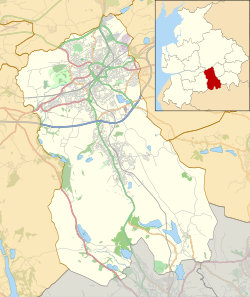Pleasington Priory
| Pleasington Priory | |
|---|---|
| Church of St Mary and St John Baptist | |

Pleasington Priory from the southeast
|
|
| Coordinates: 53°44′06″N 2°32′34″W / 53.7350°N 2.5429°W | |
| OS grid reference | SD 643,266 |
| Location | Pleasington, Lancashire |
| Country | England |
| Denomination | Roman Catholic |
| Architecture | |
| Heritage designation | Grade I |
| Designated | 24 November 1966 |
| Architect(s) | John Palmer |
| Architectural type | Church |
| Style | Gothic Revival |
| Groundbreaking | 1816 |
| Completed | 1819 |
| Construction cost | £23,000 |
| Specifications | |
| Materials | Ashlar, slate roofs |
| Administration | |
| Diocese | Salford |
Pleasington Priory, or the Church of St Mary and St John Baptist, is a Roman Catholic church in the village of Pleasington, Lancashire, England. It is recorded in the National Heritage List for England as a designated Grade I listed building. The architectural historian Nikolaus Pevsner describes it as being "an astonishing church", and the citation in the National Heritage List for England states it is an "exceptional form of Catholic chapel for the period before Emancipation".
The church was built between 1816 and 1819 as a thank offering by John Francis Butler at a cost of £23,000 (£1.57 million as of 2017), the architect being John Palmer and the sculptor Thomas Owen.
The church is built in ashlar with slate roofs. It is a large, tall church with mixed Gothic styles. Its plan consists of a five-bay nave with a clerestory, north and south aisles, and a polygonal apse. Entry to the church is at the west through a three-order portal above which are three statues on corbels. On the underside of the middle corbel is a bust of John Butler in military uniform. Above the statue is a carved arch, then a small parapet and a large rose window, and a gable with an openwork parapet surmounted by a crocketed cross. At each side of the portal is an octagonal turret with a three-stage pinnacle. Outside the turrets are offices, each with a niche containing on one side the name of the architect and on the other the sculptor. The aisles have five five-light windows and are battlemented; the clerestory has triple lancet windows and an openwork parapet. The apse has tall five-light Perpendicular windows. On the south side is a priest's door.
...
Wikipedia

